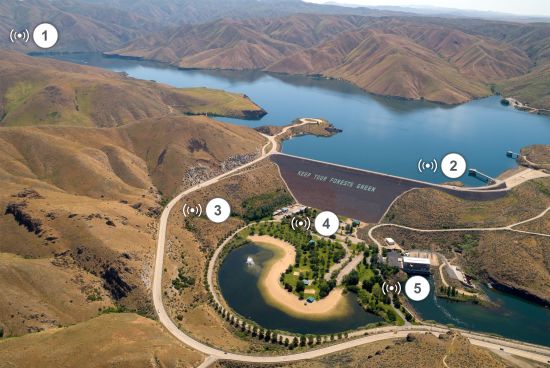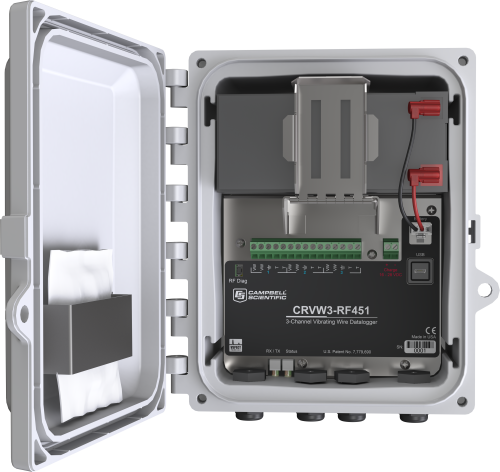Instrumentation
We offer a variety of products that can be used to create systems for Dam Monitoring - Structural. Many of the major components used to create these systems are listed below. Please let us know if we can help you configure a system.
More Details about Our Dam Monitoring - Structural Systems

- Precipitation and inflow
- Reservoir level
- Slope stability
- Seepage
- Outflow
Dam Measurement Automation Platforms
The versatility of our platforms allows them to be customized for each application. We offer a range of platforms, from the most basic device with just a few channels to expandable platforms that measure hundreds of channels. Scan rates can be programmed from once every few hours to 10,000 times per second, depending on the model. Measurement types, processing algorithms, and recording intervals are also programmable.
The measurement automation platform has a simple, yet powerful on-board instruction set: simply choose the sensor type, scan rate, and measurement channel. On-board mathematical and statistical processing allows data reduction in the field and enables measurements to be viewed in the desired units, whether that is microstrains, centimeters per second, revolutions per minute, meters, Amperes, or inches.
The versatility of the measurement automation platform extends to control as well. Each platform can monitor and control external devices based on time or measured conditions, allowing savings in time and equipment, and warning of—or possible prevention of—dangerous conditions. Our platforms automate alarm activation according to a pre-defined Trigger Action Response Plan (TARP) if measurements reach set thresholds. These platforms are rugged enough to be used in dams worldwide.
The measurement automation platform can stand alone. Once programmed and powered, no human or computer interaction is required, although data are typically downloaded to a PC or exported to the cloud for further analysis. A telecommunications or hardwire link allows critical data to be monitored and graphed in your office 24/7 rather than only in the field. Data from various stations and applications can be monitored from a single laptop or desktop computer.
The low power drain typically allows our platforms to be powered by solar panels and batteries. If 110/220-Vac power or external 12-Vdc batteries are available, you can use those as well. Non-volatile data storage and a battery-backed clock ensure data capture and integrity.
Training
Campbell Scientific offers training courses that can be conducted at your location and customized to meet your specific needs. Hands-on training with our engineers helps ensure your system provides the site condition data you need today and into the future.
Sensors Used for Dam Measurements
The versatility of our measurement automation platforms begins with sensor compatibility. Our platforms can measure virtually every commercially available sensor, allowing them to be used in different ways for a variety of measurements. For example, the following are common parameters that the sensors in our platforms measure:
- Pore water pressure
- Water level
- Water flow
- Settlement
- Displacement
- Strain
- Stress
- Tilt
- Inclination
- Weight
- Force
- Pressure
- Deflection
- Barometric pressure
- Temperature
- Humidity
- Elevation
More specifically, these are the sensor types commonly used in our measurement automation platforms:
- Piezometers
- Pressure transducers
- Inclinometers
- Tiltmeters
- Settlement sensors
- Borehole pressure cells
- Earth pressure cells
- Load cells
- Pressure cells
- Accelerometers
- Vibrating wire strain gauges
- Foil-bonded strain gauges
- Extensometers
- Jointmeters
- Crackmeters
- Strainmeters
- Deformation meters
- Barometers
- Pressure cells
- Tilt beams
- Stressmeters
- Thermistors
- Thermocouples
- Deformation sensors
- Radar water-level sensors
- Sonic water-level sensors
- Displacement transducers
- Linear variable differential transformers (LVDT)
Because our measurement automation platforms have many channel types and programmable inputs, all these sensor types can be measured by one device. Channel types include analog (single-ended and differential), pulse counter, switched excitation, continuous analog output, digital I/O, and anti-aliasing filter. Using switched or continuous excitation channels, our platforms provide excitation for ratiometric bridge measurements.
The following are common sensor measurement types that our measurement automation platforms are compatible with:
- Frequency
- Resistance
- Voltage
- Ratiometric
- Current
- Modbus RTU
- RS-485
- SDI-12
- RS-232
Communications
The availability of multiple communications options for retrieving, storing, and displaying data also allows platforms to be customized to meet your exact needs. Onsite communications options include direct connection to a PC or laptop, PC cards, storage modules, and platform keyboard/display. Telecommunications options include short-haul, telephone (including voice-synthesized and cellular), radio frequency, multidrop, and satellite.
Unlock the power of instrumentation and monitoring with our various geotechnical training options.
Case Studies
In the mountains of Antioquia, Colombia, eight of the region’s most important dams now share......read more
Overview The reconstruction of the navigational lock system at the Iron Gate I Hydroelectric Power Station......read more
Background Think of the First Transcontinental Railroad. Minor errors in surveys and maps could have led......read more
Background Tailings dams are crucial components of mining operations, responsible for storing water used in the......read more
Levees are used in every state in the US with a higher concentration in states......read more
Natural disasters occur everywhere, and California is no exception. When wildfires were rampant across the......read more
More than 50 CR10-based monitoring systems were used for structural monitoring during the construction of......read more
The Confederation Bridge is one of the world's longest continuous pre-stressed-concrete, box-girder, bridges built over......read more
Documents
Brochures
Related Product Categories
Privacy Policy Update
We've updated our privacy policy. Learn More
Customise a System
In addition to our standard systems available, many of the systems we provide are customised. Tell us what you need, and we’ll help you configure a system that meets your exact needs.










